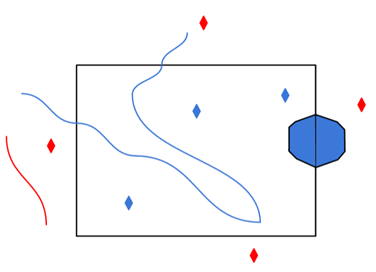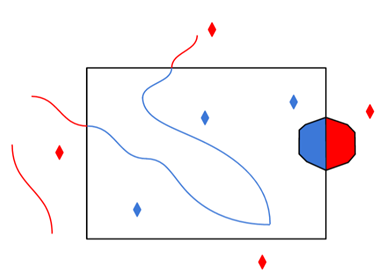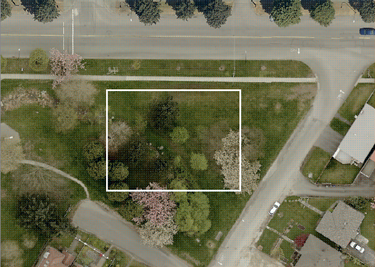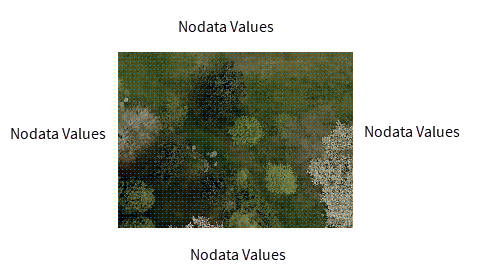Polygons
When selected, causes self-intersecting polygons to be broken up into non-intersecting polygons.
Specifies whether lines used to build polygon geometries should also be read and presented as separate lines.
Parameter File
Specify the name of the file to be used as a parameter file. This parameter file is created by the FF reader and is used to store many metadata values for future use with other formats.
A search envelope (also known as a bounding box) is a rectangular area that defines a geographic area. In FME, the easiest way to define a search envelope is to use search envelope parameters.
Defining a search envelope is the most efficient method of selecting an area of interest because FME will read only the data that is necessary – it does not have to read an entire dataset. Search Envelope parameters apply to both vector and raster datasets and can be particularly efficient if the source format has a spatial index.
Most FME readers have parameters to define the search envelope of data that is being read:
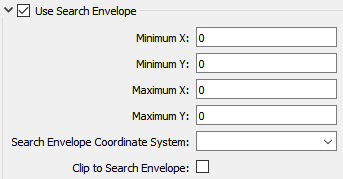
The parameters include the x and y coordinates of the bounding box as well as a parameter that defines the coordinate system.
How to Define the Bounding Box
Using the minimum and maximum x and y parameters, define a bounding box that will be used to filter the input features. Only features that intersect with the bounding box are returned. Note that the bounding box intersection is not a full geometry intersection (based on spatial relationships) that would be returned by a transformer like the SpatialFilter.
Search Envelope Coordinate System
Specifies the coordinate system of the search envelope if it is different than the coordinate system of the data. The coordinate system associated with the data to be read must always be set if this parameter is set.
If this parameter is set, the minimum and maximum points of the search envelope are reprojected from the Search Envelope Coordinate System to the reader’s coordinate system prior to applying the envelope.
The underlying function for Use Search Envelope is an intersection; however, when Clip to Search Envelope is checked, a clipping operation is also performed.
- When checked (set to Yes), this option instructs FME to clip features to the exact envelope boundary. FME removes any portions of imported features being read that are outside the search envelope.
- When left unchecked (set to No), features that overlap the boundary will be included in their full (unclipped) form.
|
Clip to Search Envelope: No |
Clip to Search Envelope: Yes |
|---|---|
|
Any features that cross the search envelope boundary will be read, including the portion that lies outside of the boundary.
|
Any features that cross the search envelope boundary will be clipped at the boundary, and only the portion that lies inside the boundary will be read.
|
|
The search envelope includes the bounding box and the extent of the raster.
|
The search envelope includes only the area within the bounding box. The raster size will still match the bounding box, but the area without data will be filled with Nodata values to represent the absence of data, if the source raster has them. Raster Nodata may be a single value across all bands, a single value per band, or a separate alpha or transparency band that indicates the lack of data values (this is more common in images than other types of rasters).
|
Advanced
Specifies whether texts attached to point geometries should be extracted to standalone texts with their own point geometry.
- Yes: Text-features are made for those points that have a list called ff_text_point{}.
- No: You can choose to create text later by using a ListExploder transformer with the ff_text_point list.
If set to No, clusters are not built. You can rebuild clusters later using the Aggregator and the ff_up_cluster attribute.
In TransferFiles (FF-files), clusters may have a mix of features with different geometry types, but by default such clusters are not built.
To build clusters with different geometries, specify Yes.
In FF, a 3D line or area (polygon) is not required to have heights on all vertices.
A vertex with unknown height will have a height value of NaN (Not a Number).
Very few formats allow vertices to have unknown heights, so this parameter allows you to replace all NaN height values with a default height value.
The dep-attribute (dep = detail type) is stored on all FF features as a string of 10 characters. Any dep-value shorter than 10 characters will have spaces padded on the left side to make the string 10 characters long. As a standard behavior, FME does not try to trim any values read from an FF file.
If this parameter is set to Yes, FME will trim those spaces from the left side of the dep-value.
